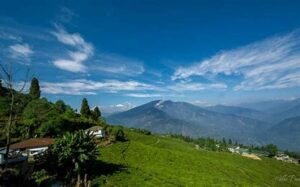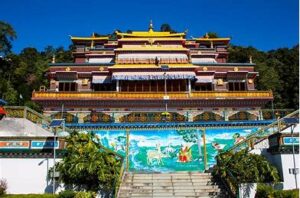Introduction
Pelling, a serene town situated in the West Sikkim district of the northeastern Indian state of Sikkim, holds geographical, cultural, and historical significance. Known for its vantage views of the Kanchenjunga range — the third highest mountain in the world — Pelling has increasingly become a subject of interest not only for tourists but also for researchers, students, and cultural scholars studying the Himalayan belt.
This blog aims to present an informative overview of Pelling, focusing on its geographical setting, socio-cultural context, religious heritage, ecological importance, and strategic location. While often associated with tourism, Pelling also contributes to Sikkim’s broader identity as a center for Himalayan studies, Buddhist traditions, and environmental conservation.
Geographical Location and Topography
Pelling is located in West Sikkim, approximately 115 kilometers west of Gangtok, the state capital, and stands at an average altitude of 2,150 meters (7,200 feet) above sea level. Geographically, it lies in the Eastern Himalayan range, with a direct line of sight to Mount Kanchenjunga (8,586 meters), which forms part of the India-Nepal border.
Topographical Features:
- The region is mountainous with steep slopes, valleys, and river systems.
- It lies within the catchment area of the Rangeet River, a major tributary of the Teesta River.
- The elevation provides a temperate climate, with snowfall occurring at higher altitudes in winter.
Pelling is part of the Himalayan biodiversity hotspot, characterized by alpine forests, subtropical broadleaf forests, and a rich variety of flora and fauna.
Kanchenjunga Range – Geographical and Cultural Relevance
One of the defining features of Pelling is its unobstructed view of the Kanchenjunga mountain range. The range comprises five peaks, often referred to as the “Five Treasures of Snow” — symbolizing gold, silver, gems, grain, and sacred scriptures in local mythology.
Importance of Kanchenjunga:
- Geological: It forms part of the greater Himalayan tectonic belt and is associated with ongoing orogenic (mountain-forming) processes.
- Cultural: In Sikkimese and Lepcha cosmology, Kanchenjunga is considered a sacred guardian deity. It is revered not as a challenge to be conquered but as a presence to be worshipped.
- Environmental: The glaciers of the Kanchenjunga range are vital for downstream water systems, including the Rangeet and Teesta rivers.
From Pelling, the Kanchenjunga is visible during much of the year, especially in the post-monsoon and winter months, which has contributed to Pelling’s identity as a key location for mountain observation and documentation.
Historical and Cultural Significance
Pelling is not a newly established town but is closely tied to Sikkim’s royal and religious history. The town and its surrounding regions, including Yuksom and Gyalshing, were part of the ancient capital corridor of the former Kingdom of Sikkim, founded in 1642.
Rabdentse – The Second Capital of Sikkim
- Located near Pelling, Rabdentse served as the capital of the Sikkimese kingdom from 1670 to 1814.
- It was established by Chador Namgyal, the third Chogyal (king) of Sikkim.
- Today, Rabdentse exists as an archaeological site with preserved palace ruins, stone structures, and ancient pathways.
- It offers insights into pre-modern Himalayan statecraft and architectural practices.
Religious and Monastic Heritage
The town is home to some of Sikkim’s most important Buddhist monastic institutions. These sites serve not only as religious centers but also as repositories of art, manuscripts, and oral history.
Pemayangtse Monastery
- One of the oldest and most significant monasteries in Sikkim, affiliated with the Nyingma sect of Tibetan Buddhism.
- Established in the 17th century, it was reserved for monks of “pure lineage” (Pemayangtse meaning “Perfect Sublime Lotus”).
- The monastery contains a rare three-dimensional wooden sculpture depicting Zangdok Palri, the celestial abode of Guru Padmasambhava.
- It plays a crucial role in religious education, Buddhist philosophy, and the annual performance of masked Cham dances.
Sangacholing Monastery
- Located on a ridge opposite Pemayangtse, it is one of the oldest monasteries in Sikkim, established in 1697.
- It continues to be a hub of spiritual practice and meditation in the region.
These monasteries are key in understanding the syncretic blend of Tibetan Buddhism and indigenous beliefs that characterize Sikkimese religious life.
Demographics and Ethnolinguistic Composition
Pelling’s population consists primarily of three ethnic groups:
- Lepchas – Indigenous inhabitants of Sikkim, believed to be the original settlers.
- Bhutias – Of Tibetan origin, they form the monastic and elite social classes in Sikkimese history.
- Nepalese – The largest demographic group in present-day Sikkim, comprising multiple castes and ethnicities such as Gurung, Tamang, and Limbu.
Languages Spoken:
- Nepali (official and widely spoken)
- Sikkimese (Bhutia)
- Lepcha
- Hindi and English (administrative and educational use)
The cultural landscape of Pelling reflects a multiethnic coexistence, where traditional attire, festivals, and crafts are still practiced and preserved.
Ecological Importance and Biodiversity
Pelling and its surrounding areas fall within the Eastern Himalayan ecosystem, which is recognized as a global biodiversity hotspot.
Flora and Fauna:
- Flora: Includes rhododendron species, oak, pine, bamboo, and medicinal plants.
- Fauna: Species such as the red panda, Himalayan black bear, barking deer, and a wide variety of birds inhabit this region.
The Kanchenjunga National Park, a UNESCO World Heritage Site, lies to the north of Pelling and represents one of the most well-preserved Himalayan biospheres in India. Pelling benefits ecologically from its proximity to this protected area.
Infrastructure and Development
While Pelling is still developing in terms of large-scale infrastructure, it has seen considerable improvement in education, electricity, telecommunication, and transportation in recent decades. Roads are maintained by state and central agencies, with Pelling connected by road to Gyalshing, Yuksom, and Gangtok.
Key Institutions:
- Government schools and regional colleges support basic education.
- Health centers and administrative offices serve the population of West Sikkim.
Efforts are ongoing to promote sustainable development through eco-friendly building codes, promotion of organic farming, and controlled tourism.
Cultural Events and Festivities
While Pelling itself does not host a state-level festival, it participates in major cultural and religious festivals celebrated throughout Sikkim:
- Losar – Tibetan New Year celebrated by the Bhutia and Tibetan Buddhist communities.
- Saga Dawa – Observed to commemorate the birth, enlightenment, and death of Lord Buddha.
- Maghe Sankranti – Celebrated by the Nepalese communities, marking the winter solstice.
- Tendong Lho Rum Faat – Celebrated by the Lepcha people, associated with legends of natural calamities.
These festivals are occasions for ritual dance, singing, and public gatherings, reflecting the living heritage and ritual calendar of the Himalayas.
Educational and Research Relevance
Due to its elevation, climate, biodiversity, and cultural assets, Pelling and its surroundings are increasingly recognized as areas of academic interest in disciplines such as:
- Himalayan studies
- Buddhist theology and iconography
- Climate and ecological research
- Ethnolinguistic anthropology
Universities and NGOs working in the Eastern Himalayas often use Pelling and West Sikkim as fieldwork sites for studying community-based conservation, traditional knowledge systems, and resilience practices among mountain communities.
Conclusion
Pelling is more than a scenic town; it is a microcosm of Himalayan life, heritage, and ecology. With its unobstructed views of Kanchenjunga, centuries-old monasteries, and a harmonious blend of diverse ethnic cultures, Pelling provides insights into how mountain communities have adapted to and revered their environment.
As regional studies and environmental awareness grow, Pelling serves as a living classroom for cultural geography, religious history, biodiversity conservation, and sustainable development. Its importance extends far beyond tourism, offering enduring relevance to scholars, students, and policy-makers interested in the Eastern Himalayas.




